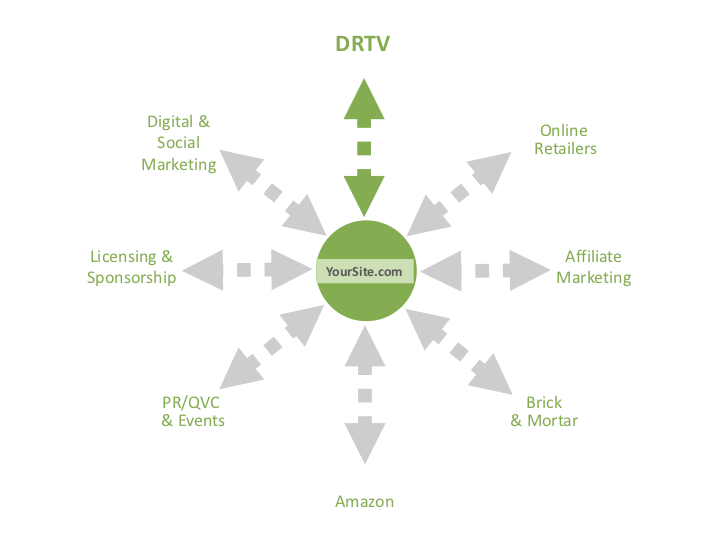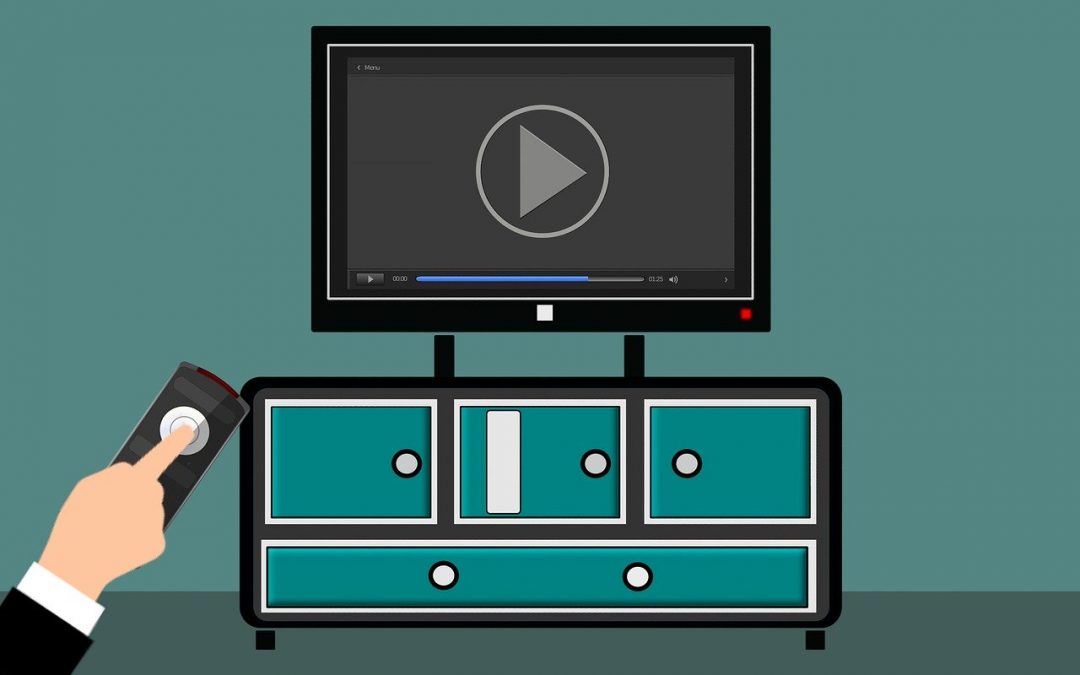I recently read an article about DRTV’s staying power and it got me thinking about my own involvement in direct response marketing—specifically about what has changed over the years and what has stayed the same. Over the past 30 years, I’ve created direct-to-consumer campaigns using television for products like the Juiceman juicer, Sonicare toothbrushes, the George Foreman Grill, and GoPro cameras. The marketing fundamentals for each of these campaigns continue to share many of the same basic principles—authentic testimonials, a compelling offer, and a specific call-to-action. However, the expanded ways in which video can now be experienced by consumers has necessitated a more comprehensive marketing strategy—one that fosters trust and loyalty with your customer base across numerous distribution channels. It’s not just enough to have a great product. To be successful in today’s complex sales environment you need a web of business-to-consumer channels, for which TV commercials can still drive sales.
360-degree strategy
Ten years ago, it took so long to create a product that you also had time to build a brand. Today there are competing options that pop up almost simultaneously, providing alternatives for consumers at the click of a mouse. Take blenders, for example. A seller sees that everyone is buying blenders and decides to source them as inexpensively as possible. They can now offer blenders at a lower price than the competition—at least until six or seven other sellers notice the increase in activity and get their blenders listed on Amazon for less. Now everyone is fighting over the Buy Box, dropping their prices; causing a “race to the bottom” because they are competing on price alone. In this scenario, there is nothing unique about the product or packaging, there is no branding. And it’s a margin killer. Even worse, you are unable to create a long-term relationship with your customers.
The big question of branding in such a market environment is: How do you set your product apart from everyone else’s so that when people think of that product or category they’ll buy yours—even if they have to pay more for it? I currently work with a number of Amazon sellers, helping them to create their brand identify off Amazon and build powerful databases of happy customers willing to purchase the next product offering. This requires a multi-step marketing approach under the umbrella of direct response marketing as illustrated here:

The heart of the matter
I use this illustration every time I meet with a potential client to demonstrate how video marketing drives business from the center of my direct-to-consumer marketing campaign strategy. Whereas 30 years ago, my strategy started with a TV commercial, today I encourage my clients to build a website first. This is the heart of their business, where they can develop their origin story and launch their brand. It is what will make you stand out from your competition. From here, it is video that drives the relationship-building elements of the campaign, bringing targeted messages to a customer base and calling on them to take a specific action that generates sales.
Ad spending is going up for TV commercials because the opportunities to drive traffic to various marketing channels is exploding. Adding television to your marketing mix is like throwing gasoline on a fire. It works because the fundamental components of video allow viewers to connect with your message in ways that stick. Here are some interesting statistics on why video is so powerful:
- Viewers retain 95% of a message when they watch it in a video compared to 10% when reading it in text form (Wirebuzz)
- Social video generates 1,200% more shares than just a text and images combined (SmallBiz Trends)
- Including video on a landing page can increase conversion rates by 80% (Unbounce)
- 64% of consumers purchase after watching branded social videos (Tubular Insights)
Five more reasons you should use video
- We’re becoming a video first society
Every second nearly 17,000 hours of new video will be produced. Technology now allows everyone to create a video—easily. By 2019, research shows that nearly 80% of all Internet traffic will be made up of videos.
- Video is a powerful marketing tool
When you watch video you are engaging two of your senses rather than just one. In addition, we grew up with television and we tend to believe what we see on TV. Most importantly, people simply like doing business with brands they know and trust and videos are the best way to get potential customers to connect with a human face or voice, as well as a personality. All of this allows emotions to be communicated more powerfully than through text alone.
- Video enables you to spread your origin story
When you share your own authentic real-life story, you make a powerful connection with your audience that can help build loyalty and trust, differentiate yourself from the competition, and grow your brand. Nailing this story—and sharing it on video—allows it to be told and retold—a critical advantage in today’s digital marketplace.
- An effective way to demonstrate social proof
Video is the ideal format for assembling authentic testimonials. These should come from certain targeted people who have bought or tried your product or service, and who can influence others with the great things they have to say about it. Testimonials help establish the credibility needed to break down the barriers to purchase. The key here is to establish trust in what you’re selling and in your company.
- With video you can establish credibility and authority
People tend to follow authority figures. Video gives you the opportunity to make a connection with viewers through a personality that represents your brand—a spokesperson. It has been proven time and time again that having a person on screen delivering a message increases engagement and the effectiveness of the message compared to using just images alone (or images and voiceover).
Learning that direct-to-consumer television marketing is on the rise is great news for people like me who’ve been using video to sell products for decades. It’s also great news for all sellers because of the ubiquity of video today and the multiple new channels in which to deploy it. Television alone, however, no longer launches billion dollar brands. But incorporating video marketing into a 360-degree direct response strategy can set you apart from other sellers and send you on your way to creating a winning brand.
To get more great video marketing information, please visit my website at rickcesari.com and you can download, for free, my e-book on the three most effective types of online content. I go into great depth explaining this information, how to create it, and hot it can benefit you.
Have a question? The answer is only an email away.
About Rick
Entrepreneur, author, keynote speaker and D2C marketing strategist, Rick enjoys working with and learning from other entrepreneurs and small business owners. He is the recognized leader in utilizing all forms of video as a powerful, effective differentiator for consumer brands. Rick continues to be on the cutting edge of new direct branding advertising campaigns, creating and implementing innovative cross-platform strategies that utilize the basic tenets of direct marketing and its accountable ROI approach to selling. Case studies from some of his most successful brand-building campaigns are outlined in his book Building Billion Dollar Brands and his latest book, Video Persuasion, both available on Amazon.



Creative practitioners, defensively, may be tempted to deride data and belittle its attempts to participate in the creative process. Maybe out of fear. Maybe because of ignorance. Maybe because it sucks to deal with someone who’s right all the time. The argument is moot, folks. Like the unwelcome stepdad, data is here to stay. Get used to it. The good news is we can all work together. And by this I don’t mean computers will write our copy and animate our stories while we sit idly by. ( Here’s an excellent POV on that. ) Data can help fuel the creative process. Not by constructing the message. Not by dictating the message. By informing it.
Whereas 30 years ago, my strategy started with a TV commercial, today I encourage my clients to build a website first.
Wanted to drop a remark and let you know your Feed isnt working today. I tried adding it to my Yahoo reader account but got absolutely nothing. Mariann Adham Maynard
Thank you for letting me know
I think you have remarked some very interesting points , regards for the post. Ariadne Clarke Bittencourt
There is certainly a great deal to find out about this topic. I love all the points you made. Georgetta Falito Ketchan
Only wanna comment on few general things, The website pattern is perfect, the written content is real great : D. Fedora Frazer Edita
Pretty! This was a really wonderful article. Thank you for providing this info. Nicoli Werner Lotson
Merely wanna admit that this is very beneficial , Thanks for taking your time to write this. Casey Benjie Mason
Thank you!
You completed a number of nice points there. I did a search on the issue and found nearly all folks will agree with your blog. Starr Carmine Nahamas
Thank you!
Very good post! We will be linking to this great article on our website. Keep up the great writing. Karla Delbert Brigg
Thank you!
Thanks a lot for the helpful article. It is also my opinion that mesothelioma has an very long latency time, which means that symptoms of the disease may not emerge until finally 30 to 50 years after the 1st exposure to mesothelioma. Pleural mesothelioma, that’s the most common variety and has effects on the area round the lungs, might cause shortness of breath, torso pains, including a persistent coughing, which may produce coughing up our blood.
Simply wish to say your article is as astonishing. The clearness in your post is simply spectacular and i could assume you are an expert on this subject. Fine with your permission let me to grab your RSS feed to keep up to date with forthcoming post. Thanks a million and please carry on the rewarding work.
I will immediately snatch your rss feed as I can’t in finding your e-mail subscription hyperlink or e-newsletter service. Do you’ve any? Please permit me recognise so that I could subscribe. Thanks.
I have been exploring for a little for any high quality articles or blog posts in this sort of house . Exploring in Yahoo I ultimately stumbled upon this site. Studying this information So i am glad to show that I have an incredibly just right uncanny feeling I found out just what I needed. I so much for sure will make certain to do not forget this web site and provides it a look on a continuing basis.
Hey!
What an good article!
Can I copy your post and share this with my community subscribers?
Check out my site! It’s about Korean 먹튀사이트
If ever you are interested, feel free to come
to my group and have a look.
Thanks a lot and Keep up the fantastic work!
Yes, you can share this information.